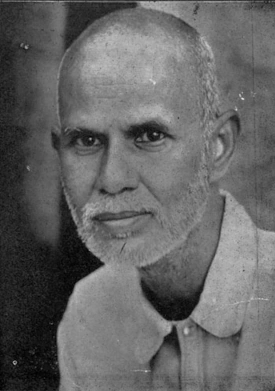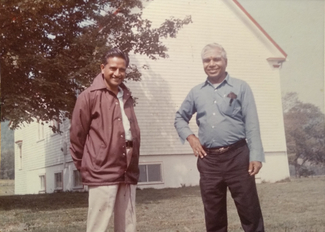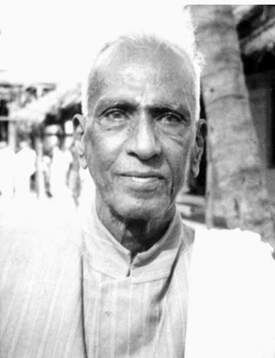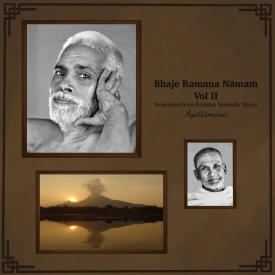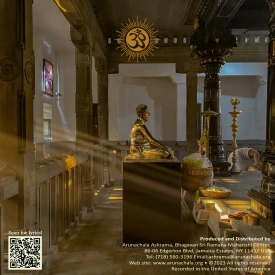Forty Verses on Reality (Uḷḷadu Nārpadu)
The Invocatory (Mangalam) Verses, part 2
We continue from Sep/Oct issue with Sri Lakshmana Sarma's commentary on the invocatory verses of Sri Ramana Maharshi's composition Forty Verses on Reality (Uḷḷadu Nārpadu), which contain the essence of Sri Bhagavan's teachings. Sri Lakshmana Sarma's commentary was lauded by Sri Bhagavan himself, who personally tutored Sri Sarma in the study of this divine work. Sri Bhagavan said: “Everyone is saying that Lakshmana Sarma’s commentary on Uḷḷadu Nārpadu is the best. Nobody has studied Uḷḷadu Nārpadu the way Sarma has.” The English translation has been done by “Kays”, to whom we are immensely grateful. It is published by Sri Ramanasramam. The recitation of Uḷḷadu Nārpadu, including the invocatory verses, is available on YouTube.
Is Brahman then insentient or not? Further, is Brahman with awareness or is awareness just its form? In other words, is consciousness an attribute or a function of Brahman or is it its very nature?
The answers to these questions are contained in the the second import of the first sentence of Uḷḷadu Nārpadu (which is:)
ii) uḷḷadu aladu uḷḷa uṇarvu uḷḷadō ?
Brahman here is not instructed as one with awareness or consciousness or knowledge but that is awareness itself. What, then, is its import? The one with awareness or knowledge as its function or attribute is simply the intellect which is none other than the mind. Awareness or knowledge is not the innate nature of the mind but is its property or function. Therefore, this knowledge of the mind is inconstant and impermanent. In dreamless sleep, the awareness of the mind subsides. Unlike this, the awareness that is the form of Brahman is eternal and changeless, for awareness is not its function. The inalienable awareness, the very form of Brahman, is imperishable, unlike the mind that loses its awareness and perishes when plunged into swoon or sleep. Its 'consciousness' form is inviolable and unaffected by time, space or by any other factor. It remains all by itself in utter ‘loneness’ even when all the worlds become naught or extinct.
Though that ‘Brahman is the very form of awareness or knowledge’ deserves to be accepted by us by the sheer strength of the teaching itself, it can also be ascertained through logical reasoning supported by inferential deductions. The first of the two imports of the first sentence contains one such reasoning where we saw that Brahman indeed is the origin wherefrom mind and thoughts arise and subside. Mind is sentient or an object with awareness and it follows that the object of its origin must either be with awareness or awareness itself. If it is merely with awareness, it becomes just another object like mind and cannot be Sat or a permanent entity or ‘That which ever is’. Therefore, it is neither insentient (jaḍa) nor one with awareness. What is it, then? That, then, is indeed awareness or chit or chaitanya (sentience) itself. The conclusively established doctrine of the entire gamut of the Vedanta is that the Self that is Brahman is not one with awareness but it is chaitanya or sentience itself. Hence it is called Sat-Chit. There are other arguments as well and one such rationale is as follows: since Brahman cannot be spoken of as one with awareness it must be either jaḍa (insentient) or chaitanya (sentient). If not jaḍa, it will be inferred to be sentient. It cannot be called insentient for then it would imply that it is not Self-effulgent since all that is jīva or insentient, not being Self-revealing, shine by the light of some other awareness. Then the question arises: ‘By what light of awareness does Brahman shine?’, to which the protagonist will say ‘By some sentience or awareness that is other than that.’ It would at once be asked whether that Chit or awareness is Sat or Asat. (The test of reality is continuity of existence without change – it should always be real; be present at all times; not be confined by names and forms or other limitations.) It can’t be postulated as asat for nothing can be made to shine by asat. If it is said to be sat, then it will necessarily have to be sat and chit, which means that the same vastu can be both sat and chit. This has been accepted and nothing prevents one from concluding that the aforesaid sat – that Brahman – be chit as well. This is the best way logically. That sat, that is the substratum of the world, is Self-revealing in its own Self-effulgence, requiring no other awareness to reveal it. Abandoning this reasoning if that sat is argued to be non Self-effulgent, the other chit that reveals it also cannot be presumed to be Self-effulgent either, by the same logic requiring yet another chit to light it up and reveal the earlier chit. Thus the projection of countless non Self-effulgent chits will have to go on ad infinitum, and the argument would suffer from the fallacy of anavastā doṣam or making it interminable. Brahman, the satvastu, that which is, is chit by itself, is the fair and logical conclusion by all these and anything contrary to this must be deemed as fallacious.
The nature of Brahman is thus conclusively seen to be two-fold: namely ‘being’ (sat) and ‘awareness’ (chit) thereby coming to be known as sat-chit. Sat means ‘That which is’ and chit means ‘the existent feeling’ or ‘awareness’ or jñāna or sentience. One should not give way to delusion – wondering ‘Is this all the svarupa – the nature and form of Brahman?’ What has been attempted to reveal is that the nature of Brahman is other than the unreal world and mind and by no means a description in full of the svarupa or the real nature of Brahman, which can be known only by the direct and most immediate experience and not in any other way, logical or otherwise.
The fact that Brahman is the form of chit does in no way mean that the mind that is seemingly sentient is chit in truth. That it is jaḍa or insentient just like the world is what is asserted and further explained in verse 22 of this text that starts with matikkoḷi taṇḍu (imparting to the mind the light of consciousness).
If we are, in truth, that sat-chit-ananda, Brahman, in other words, if that be our Self, why then are we not aware of our true reality? Why do we regard ourselves as these mean jīvās or these bodies or worldlings exposed to the trammels of saṃsāra? The following sentence provides the answer to this query.
iii) uḷḷa poruḷ uḷḷalaṟa uḷḷattē uḷḷadāl
uḷḷameṉum uḷḷaporuḷ uḷḷal evaṉ ?
Bhagavan himself has graciously clarified that here the word evaṇ (who) must be taken in two senses as ‘who’ and ‘how’. This statement affirms that Brahman is without a mind and ever tranquil. It is in the ‘Heart’ called uḷḷam or hṛdayam. That Brahman, ‘That which is’, shines as it is, only in the Heart where the mind is extinct. In an externalized and active mind (in an extroverted mind, it will not shine as it truly is which means then it will appear only as the individual soul, God and the world. This is one of the numerous reasons why Brahman is beyond contemplation by the mind.
One of them is expounded in the 22nd verse matikkoḷi taṇḍu – imparting the light of awareness to the mind. Two reasons are posited here. The nature of the mind is to superimpose on the immaculate non-dual Brahman imagined differences and venerate them as real, is one. A sentient being – a jīvā – as other than Brahman, to contemplate on it, is non-existent, is the other.
Let us analyze the first one. The mind creates an imaginary, ‘within’, and ‘without’ and further creates in the imaginary without many worlds, the other jīvās or individual souls and God. This is but the innate nature of the mind. We have already seen that Brahman is the sole basic truth as the substratum for all these imaginary projections, and as such they are mere superimpositions on the Brahman. By the logic of the imagined superimpositions concealing and preventing the substantive truth of the underlying ground reality from shining as it truly is, we know that the projected world and others obstruct the adhiṣṭhāna - Brahman - from shining as it is. So long the mind is externalized, thus long will Brahman appear as the world, individual soul and God and not as Brahman. But if the mind were to be inward-turned, it uniting itself with the Heart – the place of its origin – it loses its nature as mind and abides there. Then the imagined triad disappearing, Brahman shines with no let or hindrance as the Self; though the mind can neither perceive nor know it.
Though the ‘Heart’ - uḷḷam - is spoken of here as being the seat of Brahman, since in truth, it is not other than Brahman, it is neither a seat or dwelling place nor is Brahman confined to any one specified place alone. The Heart is spoken of as the seat of Brahman to stress the need for the aspirant desiring the experience of being the Self to become inward-turned, abandoning the mind's tendency to be exteriorized. That uḷḷam, the Heart, itself is Brahman and Brahman is the Heart is elucidated by the words uḷḷameṛum uḷḷaporuṛ - the satvastu that is uḷḷameṉum uḷḷaporuḷ.
As Brahman is said to be in the Heart, it shines as it is with the subsidence of the mind and will not shine when the exteriorized mind indulges in frenzied activity. Then the three, the imagined triad, will veil Brahman: thus it is known that Brahman will not be known to people with moorings externalized.
The other reason advanced is that there is no sentient being other than Brahman, as one apart from it, to contemplate it. The jīvā who fondly prides himself as the knower of other objects, we have seen, is but a spurious one – pōliuyir. When the mind is outward-bent, such a one will appear as if real; but if the mind, turned inward, subsides in the Heart, he, annihilated, becomes extinct. He, being an imagined entity, is naught one to contemplate on Brahman – it is said Brahman cannot be contemplated on.
But then, is there or not a way at all to meditate (uḷḷuvadaṛku) on the Self or Brahman? The fourth sentence of this veṇbā gives a meet response to this question.
iv) uḷḷattē uḷḷa paḍi uḷḷadē uḷḷal uṇar
The true meditation of the supreme reality (Brahman) is to be as that Brahman (Self) itself is, in the thought-free state, is the import of this sentence.
The mind sunk within becoming united as one with Brahman which is not other than the Heart, losing its nature as mind and remaining as Self, ‘moveless’ and quiescent peace is true meditation.
This is called the state of experience of Self knowledge. Though it is described as ‘meditation’ it is not one conducted by the mind. Contemplation by the mind is accompanied by the triad of meditator, object of meditation, and the meditation. But this state is bereft of a triputi. Other than this, as no other form of meditation is acceptable, this itself is called ‘meditation’. Bhagavan used to say that puja, devotion, vision and knowledge are all only this. They are all contained in this. This state is called deliverance and turīya.
— To be continued...Complete and Total Self-Submission
Sri Arunachala Bhakta Bhagawata (November 8, 1912 – April 12, 2000), founder of Arunachala Ashrama, was completely dedicated to his guru, Sri Ramana Maharshi. He felt that Sri Bhagavan was for him the sun of suns, and indeed stated that he saw Sri Bhagavan before him more clearly than he saw the sun! His every waking hour was filled with the presence of his Sat Guru, and in sharing the blessings that he had received from Him with the devotees who came to the ashrama to participate in the recitations, prayers and the practice of Atma Vichara that continued unabatedly. Sri Bhagawata referred to the ashrama as "AAA" that is, “Arunachala Abhyasa Ashrama”, as he gave paramount importance to the practice of “Who Am I?”, as extolled by Sri Bhagavan. For Sri Bhagawata, the principle means of sharing his hopes and aspirations with his guru was by means of his trusted and faithful typewriter, the Hermes 3000. He could be seen typing his prayer and petitions on paper for hours on end. If there was a break in the expression of his longings in this manner, if the rhythmic tapping of the keyboard stopped, it simply meant that he had become totally indrawn into that silence and vastness at the feet of Sri Bhagavan. After some time, the sound of the typewriter would be heard again, and the praise of his guru would recommence. These Prayer Manuscripts, as they are referred to, totalled perhaps thousands upon thousands of pages; the exact number is unknown. One piece alone came to 3,500 pages.
Other pages of Bhagawata's 'Prayer Manuscript' are available in the Ashrama Archive.
We share below a prayer manuscript written in November, 1990. The underlined words are typically seen in his original manuscripts, giving added emphasis to the exhortations of Sri Bhagawata.
Sri Arunachaleshwarar Shiva, Bhagavan Sri Ramana Maharshi Paramatman Sachchidananda Dakshinamurty Sarveshwarar Jadadishwarar Antaryami Sadguru tells me every single moment of my life that he has already blessed, graced and endowed me with the burning aspiration of flooding the ten directions of the globe with his direct path of the practice of Self-inquiry of “Who Am I?” and I should have not only faith but patience too, and at the right time and in the right way he would build his own mandiram in New York City. The dream of building Sri Lalita Jagadishwari Mandiram on Fifth Avenue in New York City has already been accomplished as I have been absorbed in his name and form and day and night I remember “om namo bhagavate śrī ramaṇāya”, with as much faith and fortitude as is humanly possible. From the very start of my bodily advent on this earth, Sri Ramana Arunachala Bhagavan has caught me and kept me bound to his lotus feet. I shall have to have complete and total faith in his power and glory, and thus keep marching along, marching along towards the shining and dazzling peaks of the holy hill of the holy Arunachala mountain. Sri Bhagavan has dissolved me in the ocean of his infinite blessings and benediction and has allowed me to work as much as possible for me to repeat, resound and reverberate his name all over the world. Although there is not the least sign of any promise for the realization of the New York City Madiram, nevertheless, my heart-cavity is overflowing with the surging Ganga of Jnana, Bhakti, Tyaga and Tapasya.
The Sanctum Sanctorum of my Heart-lotus is so much filled with Ramana Bhagavan’s presence that I have no room there for anything else. I am carried forwards towards the holy Arunachala mountain, and all my work is melted in his lotus feet and I sit back in the chair with my eyes closed and abide in his name, “om namo bhagavate śrī ramaṇāya”, once and for all. Each and every exhalation and inhalation of my breath carries the Lord’s name and form and with undivided attention I continue to experience Ramana Arunachala Bhagavan’s gleaming and glowing presence before me and within me. This work of pounding the great teacher, mentor and instructor, Hermes 3000, is the direct result of Sri Arunachala Ramana Bhagavan’s love and affection, and he commands and commissions me to disburse this great gift and wealth to all his children in the world of names and forms. This state of my life is beyond description and in silence I continue to bow down to his lotus feet and record all these experiences for the world so that the people of this universe wouldn’t think that my efforts and endeavours have been in vain in the Sri Arunachala Ashrama, Bhagavan Sri Ramana Maharshi Center. All my life, Sri Bhagavan has endowed me with the single proclamation that Bhagavan Sri Ramana Maharshi showers his infinite grace and mercy upon all his children, before he gives me that worldly wealth for building his temple.
The unceasing inherence in his name, “om namo bhagavate śrī ramaṇāya”, is the inexplicable and inexpressible wealth with which I have been made richer, richer and richer in this world and during all the hours of waking and dreaming and sound sleeping, Sri Bhagavan keeps me submerged in the ocean of being, consciousness and bliss and thus allows me to devote and dedicate each and every moment of my life to the practice of Who Am I?, Who Am I? Whomsoever I happen to serve in any capacity and in any form, Sri Arunachala Shiva Bhagavan Sri Ramana Maharshi soaks and saturates me with so much of his love and affection that I never discriminate as to whom I am serving and what I am doing. Sri Bhagavan permeates and pervades each and every atom and proton of my life and tells me that he is ever holding me by the hand and is leading me to his supreme abode in the cavity of the Heart. Time and time again Arunachala has taught me to welcome any adversity, obstruction or opposition with his name on the tip of my tongue and thus I will be able to dive deeper, deeper and deeper in his ocean of infinite grace and mercy. I must admit that the brickbats and bullets of unkind words and thought affect and irritate me without fail, but I simply take his name and beg and beseech him to enable me to flood the earth with all my love, affection, devotion and dedication. I have to remember all the time that the Lord is familiar with my pain and suffering, and I should depend on him with complete and total surrender. My breath is merged in the depth of my Heart, and I experience his presence.
— Sri Arunachala Bhakta BhagawataThe Elixir of Youth
The frosty years have in their grip This ailing body that at last Into Death's refuse-bin must slip. Then let it go, Quick or slow, Like autumn flower in wintry blast. For I have drunk youth's elixir, His joy made firm, his follies fled. Life like a May-day chorister Throbs into song. The heart, grown strong, Dances and sings where grief lies dead. This world and body are not me. They are a dream from which to wake. Whatever in their fate may be Cannot destroy The vibrant joy Or turn to night the bright daybreak. When even imperfect sight can bring Such joyful certitude as this, Who to the seeming self would cling, In a barren land where no birds sing, Lost to Awareness, Being, Bliss?
Surrender to Sri Bhagavan
The greatness of complete and total self-surrender is again extolled by Sri Devaraja Mudaliar.
I had gone to the Asramam on April 27th, 1947, on hearing of Sri Bhagavan’s illness. After three weeks’ stay I was intending to return on May 18th. The day previous to my intended departure I fell into a mood of deep despondency at the thought that Bhagavan was not doing for me all that he should have done, but was allowing me to drift my own way, perhaps deeming me to be beyond all redemption. In that mood, about 3 o’clock in the afternoon, I said to him: “Bhagavan, here are a few stanzas which eloquently describe how I feel at this moment. I pray for Bhagavan’s kind attention to them while I sing them.” So saying, I recited the three following stanzas of Sivaprakasam Pillai:
“You have taught me that though we may plan crores of things, nothing fructifies without God’s Grace, and that therefore the best devotee is he who does not plan anything. And yet, I have not taken your teaching firmly to heart or controlled my mind.
“I do not follow the supreme path which you, my rare Guru, have taught. I do not give up my attachment to the world. You have made me mentally aware of the truth that I am not this perishable body. But you have not vouchsafed me practical realization of the truth. A kind master should control and save his slave and not abandon him in disgust as an incorrigible brute.
“If you continue thus, leaving me poor to go my ways, how am I to be saved? Weakling that I am, I will not correct myself, and you, my Lord and master will not correct me. Have I any help except you in this life or the next? Tell me, what exactly do you intend to do with me? Is this right of you, my Guru?”
Bhagavan kept quiet for one or two minutes after I had finished this earnest prayer and then, out of his boundless grace, was pleased to tell me: “Whether I do or don’t do anything, why not simply surrender and keep quiet?”
Here I must say that the only method I have adopted to achieve liberation or Self-realization is simply to throw myself on Bhagavan, to surrender to him completely as lies in my power, and to leave everything else to him. And Bhagavan’s teaching, the last I ever got from him before his Mahasamadhi, was just this: “Your business is simply to surrender and leave everything to me. If one really surrenders completely, there is no room for one to complain that the Guru has not done this or that.”
This is not a new teaching to me or anyone else. However, coming to me in that context and probably because Bhagavan willed it so, it gave me great satisfaction and solace, convincing me that, whatever appearances might indicate, Bhagavan was looking after me and it was foolish for me to imagine that he was not doing this or that for me or to give way to worry or despondency about it.
To me and a number of other devotees of Bhagavan, he was God and all in all. We felt as Saint Arunagirinathar felt when he declared to Lord Muruga: “I have none except you and will follow none except you.” I have often sung this song before Bhagavan, substituting ‘Bhagavan’ for ‘Muruga’ in the last two lines. But about whomsoever we sang, whichever temple we visited, or whatever image we worshipped, our homage always went to Bhagavan.
— My Recollections of Bhagavan Sri RamanaBhaje Ramana Namam, Vol. II
This new collection of songs by Srimati Sangeetha Swaminathan is based on the text of the divine Ramana Sannidhi Murai, composed by Sri Muruganar. Bhaje Ramanana Namam, Vol. II was officially released on Sept. 1st, Advent Day, in Sri Ramanasramam. The official North American release occurred during the 100th Anniversary of Sri Ramanasramam Celebration which was celebrated by Arunachala Ashrama on Sept. 30, 2023.
Originally inspired and encouraged by Sri Ravi Ramanan, this garland of songs is a heart-melting offering to Sri Bhagavan. Srimati Sangeetha Swaminathan transports us to Sri Bhagavan's presence by her devotional mastery. Her talented accompanying musicians provide solid support for her songs of praise. Please visit bhaje-rn-v2 to listen to these rapturous offerings, and for the booklet containing the lyrics and translation of the songs.
Other contributors include: Keerthana Srikanth, Niranjana Ganesh, Lavanya Hari, Swaminathan Venkataraman in the chorus; Vignesh Thyagarajan on violin; Guitar by Rishabha Swaminathan; Tabla artistry by Ravi Gutala; Photographs shared by Sri Ramanasramam and Michael Highburger; Translations by Prof.K.Swaminathan and Hari Murthy and Cover Art by Sandhya Ganesh.
The album has been produced by Arunachala Ashrama, New York. It is a boon for devotees of Sri Bhagavan the world over.



